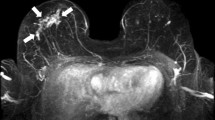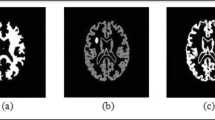Abstract
In medical domain, diseases in critical internal organs are generally inspected using invasive/non-invasive imaging techniques. Magnetic resonance imaging (MRI) is one of the commonly considered imaging approaches to confirm the abnormality in various internal organs. After recording the MRI, an appropriate image processing exercise is to be implemented to investigate and infer the severity of the disease and its location. This paper proposes a semi-automated tool to investigate the medical MRI captured with contrast improved T1 modality (T1C). This technique considers the integration of Bat algorithm (BA) and Tsallis based thresholding along with region growing (RG) segmentation. Proposed approach is tested on RGB/gray scale images of brain and breast MRI recorded along with a contrast agent. After mining the infected region, its texture features are extracted with Haralick function to assess the surface details of abnormal section. Performance of RG is confirmed against other segmentation methods, such as level set (LS), principal component analysis (PCA) and watershed. The clinical significance of the proposed technique is also validated using the brain images of BRATS recorded using T1C modality. The experiment outcome confirms that, the implemented procedure provides better values of Jaccard (87.41%), Dice (90.36%), sensitivity (98.27%), specificity (97.72%), accuracy (97.53%) and precision (95.85%) for the considered BRATS brain MRI.







Similar content being viewed by others
References
Amin J, Sharif M, Yasmin M, Ali H, Fernandes SL (2017a) A method for the detection and classification of diabetic retinopathy using structural predictors of bright lesions. J Comput Sci Neth 19:153–164
Amin J, Sharif M, Yasmin M, Fernandes SL (2017b) A distinctive approach in brain tumor detection and classification using MRI. Pattern Recognit Lett. https://doi.org/10.1016/j.patrec.2017.10.036
Bokhari STF, Sharif M, Yasmin M, Fernandes SL (2018) Fundus image segmentation and feature extraction for the detection of glaucoma: a new approach. Curr Med Imaging Rev 14(1):77–87
Brats (Brain Tumor Database (BraTS-MICCAI) (2018) http://hal.inria.fr/hal-00935640)
Chaddad A (2015) Automated feature extraction in brain tumor by magnetic resonance imaging using gaussian mixture models. Int J Biomed Imaging 2015:868031. https://doi.org/10.1155/2015/868031
Chakraborty S, Chatterjee S, Ashour AS, Mali K, Dey N (2017) Intelligent computing in medical imaging: a study. Adv Appl Metaheuristic Comput. https://doi.org/10.4018/978-1-5225-4151-6.ch006
Chawla M, Duhan M (2015) Bat algorithm: a survey of the state-of-the-art. Appl Artif Intell Int J 29(6):617–634
Deng W, Xiao W, Deng H, Liu J (2010) MRI brain tumor segmentation with region growing method based on the gradients and variances along and inside of the boundary curve. In: 3rd International conference on biomedical engineering and informatics (BMEI). https://doi.org/10.1109/BMEI.2010.5639536
Dey N et al (2015) Parameter optimization for local polynomial approximation based intersection confidence interval filter using genetic algorithm: an application for brain MRI image de-noising. J Imaging 1(1):60–84
Dey N, Rajinikanth V, Ashour AS, Tavares JMRS. (2018) Social group optimization supported segmentation and evaluation of skin melanoma images. Symmetry 10(2):51
Fernandes SL, Gurupur VP, Lin H, Martis RJ (2017) A novel fusion approach for early lung cancer detection using computer aided diagnosis techniques. J Med Imaging Health Inform 7(8):1841–1850
Garg G, Juneja M (2018) A survey of prostate segmentation techniques in different imaging modalities. Curr Med Imaging Rev 14(1):19–46
Haralick RM, Shanmugam K, Dinstein I (1973) Textural features for Image classification. IEEE Trans Syst Man Cybern 3(6):610–621
Ikeda K (1979) Multiple-valued stationary state and its instability of the transmitted light by a ring cavity system. Opt Commun 30:257–261
Ikeda K, Daido H, Akimoto O (1980) Optical turbulence: chaoticbehavior of transmitted light from a ring cavity. Phys Rev Lett 45:709–712
Kalavathi P (2013) Brain tissue segmentation in MR brain images using multiple Otsu’s thresholding technique. In: 8th International conference on computer science and education (ICCSE). https://doi.org/10.1109/ICCSE.2013.6553987
Kanda T, Ishii K, Kawaguchi H et al. (2013) High signal intensity in the dentate nucleus and globus pallidus on unenhanced T1-weighted MR images: relationship with increasing cumulative dose of a gadolinium-based contrast material. Radiology 270(3):834–841. https://doi.org/10.1148/radiol.13131669
Khalid NEA, Ibrahim S, Manaf M, Ngah UK (2010) Seed-based region growing study for brain abnormalities segmentation. In: International symposium on information technology (ITSim). https://doi.org/10.1109/ITSIM.2010.5561560
Li C, Xu C, Gui C, Fox MD (2010) Distance regularized level set evolution and its application to image segmentation. IEEE Trans Image Process 19(12):3243–3254
Li Z, Dey N, Ashour AS et al (2017) Convolutional neural network based clustering and manifold learning method for diabetic plantar pressure imaging dataset. J Med Imaging Health Inform 7(3):639–652
Macenko M, Celenk M, Ma L (2006) Lesion detection using morphological watershed segmentation and model based inverse filtering. In: 18th International conference on pattern recognition (ICPR 2006). https://doi.org/10.1109/ICPR.2006.759
Madhuvanthi S, Madhumathi K, Deepa P, Raja NSM (2017) A soft-computing assisted tool to detect and analyse brain tumor. Int J Eng Technol (IJET) 9(2):1341–1348
Manic KS, Priya RK, Rajinikanth V (2016) Image multithresholding based on Kapur/Tsallis entropy and firefly algorithm. Indian J Sci Technol 9(12):89949
Manickavasagam K, Sutha S, Kamalanand K (2014) Development of systems for classification of different plasmodium species in thin blood smear microscopic images. J Adv Microsc Res 9(2):86–92
Menze et al (2015) The multimodal brain tumor image segmentation benchmark (BRATS). IEEE Trans Med Imaging 34(10):1993–2024
Moghaddam RF, Cheriet M (2010) A multi-scale framework for adaptive binarization of degraded document images. Pattern Recognit 43(6):2186–2198
Namburu A, Samay SK, Edara SR (2017) Soft fuzzy rough set-based MR brain image segmentation. Appl Soft Comput 54:456–466
Naqi SM, Sharif M, Yasmin M M, and Fernandes SL SL (2018) Lung nodule detection using polygon approximation and hybrid features from CT images. Curr Med Imaging Rev 14(1):108–117
Olchowy et al (2017) The presence of the gadolinium-based contrast agent depositions in the brain and symptoms of gadolinium neurotoxicity—a systematic review. PLoS ONE 12(2):e0171704
Palani TK, Parvathavarthini B, Chitra K (2016) Segmentation of brain regions by integrating meta heuristic multilevel threshold with Markov random field. Curr Med Imaging Rev 12(1):4–12
Radiopaedia1 (2018) (Cerebral infarction database. Case courtesy of Dr Ahmed Abd Rabou, Radiopaedia.org, rID: 25281)
Radiopaedia2 (2018) (Sub-acute middle cerebral artery infarct database. Case courtesy of Dr David Cuete, Radiopaedia.org, rID: 35732)
Radiopaedia3 (2018) (Pseudoangiomatous. Case courtesy of Dr Enrico Citarella, Radiopaedia.org, rID: 39249)
Raja NSM, Kavitha G, Ramakrishnan S (2012) Analysis of vasculature in human retinal images using particle swarm optimization based Tsallis multi-level thresholding and similarity measures. LNCS 7677:380–387
Raja NSM, Rajinikanth V, Latha K (2014) Otsu based optimal multilevel image thresholding using firefly algorithm. Model Simul Eng 2014:794574. https://doi.org/10.1155/2014/794574
Raja NSM, Rajinikanth V, Fernandes SL, Satapathy SC (2017) Segmentation of breast thermal images using Kapur’s entropy and hidden Markov random field. J Med Imaging Health Inform 7(8):1825–1829
Rajinikanth V, Satapathy SC (2018) Segmentation of ischemic stroke lesion in brain MRI based on social group optimization and fuzzy-Tsallis entropy. Arab J Sci Eng. https://doi.org/10.1007/s13369-017-3053-6
Rajinikanth V, Raja NSM, Kamalanand K (2017a) Firefly algorithm assisted segmentation of tumor from brain MRI using Tsallis function and Markov random field. Control Eng Appl Inform 19(3):97–106
Rajinikanth V, Raja NSM, Satapathy SC, Fernandes SL (2017b) Otsu’s multi-thresholding and active contour snake model to segment dermoscopy images. J Med Imaging Health Inform 7(8):1837–1840
Rajinikanth V, Fernandes SL, Bhushan B, Sunder NR (2018a) Segmentation and analysis of brain tumor using Tsallis entropy and regularised level set. LNEE 434:313–321
Rajinikanth V, Satapathy SC, Dey N, Vijayarajan R (2018b) DWT-PCA image fusion technique to improve segmentation accuracy in brain tumor analysis. LNEE 471:453–462
Rajinikanth V, Dey N, Satapathy SC, Ashour AS (2018c) An approach to examine magnetic resonance angiography based on Tsallis entropy and deformable snake model. Future Gener Comput Syst 85:160–172
Roopini IT, Vasanthi M, Rajinikanth V, Rekha M, Sangeetha M (2018) Segmentation of tumor from brain MRI using fuzzy entropy and distance regularised level set. LNEE 490:297–304
Satapathy SC, Raja NSM, Rajinikanth V, Ashour AS, Dey N (2018) Multi-level image thresholding using Otsu and chaotic bat algorithm. Neural Comput Appl 29(12):1285–1307. https://doi.org/10.1007/s00521-016-2645-5
Scan (2018) M/S. Proscans Diagnostics Pvt. Ltd., Chennai. https://proscans.in/
Shree TDV, Revanth K, Raja NSM, Rajinikanth V (2018) A hybrid image processing approach to examine abnormality in retinal optic disc. Procedia Comput Sci 125:157–164
Shriranjani D, Tebby SG, Satapathy SC, Dey N, Rajinikanth V (2018) Kapur’s entropy and active contour-based segmentation and analysis of retinal optic disc. LNEE 490:287–295
Somasundaram K, Kalavathi P (2013) Contour-based brain segmentation method for magnetic resonance imaging human head scans. Journal of computer assisted tomography. J Comput Assist Tomogr 37(3):353–368
Somasundaram K, Kalavathi P (2014) Brain segmentation in magnetic resonance human head scans using multi-seeded region growing. Imaging Sci J 62(5):273–284
Sun HQ, Luo YJ (2009) Adaptive watershed segmentation of binary particle image. J Microsc. https://doi.org/10.1111/j.1365-2818.2009.03125.x
Tsallis C (1988) Possible generalization of Boltzmann–Gibbs statistics. J Stat Phys 52(1):479–487
Tuan TM et al (2018) Dental diagnosis from X-ray images: an expert system based on fuzzy computing. Biomed Signal Process 39:64–73. https://doi.org/10.1016/j.bspc.2017.07.005
Vaishnavi GK, Jeevananthan K, Begum SR, Kamalanand K (2014) Geometrical analysis of schistosome egg images using distance regularized level set method for automated species identification. J Bioinform Intell Control 3(2):147–152
Vishnupriya R, Raja NSM, Rajinikanth V (2017) An efficient clustering technique and analysis of infrared thermograms. In: 2017 3rd International conference on bio signals, images and instrumentation (ICBSII), pp 1–5. https://doi.org/10.1109/ICBSII.2017.8082275
Warner HM, Batty R, Hart AR, Mordekar SR, Raghavan A, Williams F, Connolly DJA (2018) CT and MR imaging of the encephalopathic child. Curr Med Imaging Rev 14(2):196–206
Yang X-S (2008) Nature-inspired metaheuristic algorithms, 2nd edn. Luniver Press, Frome
Yang X-S (2013) Bat algorithm: literature review and applications. Int J Bio Inspired Comput 5(3):141–149
Zhang Y, Wu L (2012) An MR brain images classifier via principal component analysis and kernel support vector machine. Prog Electromagn Res 130:369–388
Acknowledgements
The authors of this paper would like to acknowledge M/S. Proscans Diagnostics Pvt. Ltd., a leading scan centre in Chennai for providing the clinical brain MRI for experimental investigation.
Author information
Authors and Affiliations
Corresponding author
Ethics declarations
Conflict of interest
The authors declare no conflict of interest.
Additional information
Publisher’s Note
Springer Nature remains neutral with regard to jurisdictional claims in published maps and institutional affiliations.
Rights and permissions
About this article
Cite this article
Raja, N.S.M., Fernandes, S.L., Dey, N. et al. Contrast enhanced medical MRI evaluation using Tsallis entropy and region growing segmentation. J Ambient Intell Human Comput 15, 961–972 (2024). https://doi.org/10.1007/s12652-018-0854-8
Received:
Accepted:
Published:
Issue Date:
DOI: https://doi.org/10.1007/s12652-018-0854-8




